What was once a brief moment of idle curiosity several years ago has recently blossomed into a question that resulted in the title of this post. It was rather a surprise because, given the type of art created by Boleslaw Cybis himself, Staffordshire export china would seem a very unlikely genre to appeal to him. That said, it might be that the actual collector was his wife, Marja Tym Cybis, who seems to have been a bit more traditional and lower-key than her husband.
 The moment of idle curiosity was prompted by the notice that was placed by a local auction service in the Princeton newspaper to advertise the estate sale held in May 1959, one year after Marja Cybis’ death. The headline reads Estate Maria Cybis (Collector and Potter) and the ad specifically mentions
The moment of idle curiosity was prompted by the notice that was placed by a local auction service in the Princeton newspaper to advertise the estate sale held in May 1959, one year after Marja Cybis’ death. The headline reads Estate Maria Cybis (Collector and Potter) and the ad specifically mentions
A lifetime collection of 2,000 rare Historical china and decorative items – Rare Detroit and New Jersey Coat of Arms Platters; plus Fairmount, Landing of Lafayette; States; La Grange; Boston Statehouse; Heights Near Brooklyn; Wilkie Don Quixote; Dr. Syntax platters in all sizes. 100s of dinner, luncheon, salad and cup plates depicting Eagles; Erie Canal; Fulton’s Steamboat; Cadmus; Fairmount and Philadelphia Bank; Union Line Steamboat; Rare Hospital & Almshouse scenes; Castle Garden; Lafayette; American Eagle; B&O Railroad; McDonough’s Victory; States Plates; Park Theatre; Pittsfield.
Capital Washington; Franklin’s Tomb; Table Rock; Peace and Plenty; Landing of Pilgrims; Texan Campaign plus dozens of other subjects!! Also 100s sepia, pink, lavender, black and green subjects!! Also Historical Blue and Liverpool pitchers; tea sets; covered dishes, bowls and compotes; Etc.!
The ad goes on to cite “100s of Original Cordey Figurines, bisque, bronze and metal figures.” Non-ceramic items included paintings and pictures, two tapestries, a carousel horse, pewter, carved columns, a stereopticon (really!), art books and “art scrap books” (one wonders if those had photos of Cybis creations in them), ironstone, and display cases. Quite a selection!
When I saw this ad, I found it hard to imagine that the Cybises would have been able (or want) to build such a large collection. I assumed that the auctioneer had done what many do, which is to combine one consignor’s estate/collection with another in order to have plenty of lots to offer.
About a month later, the same auctioneer held a repeat auction for the items that had not sold at the initial sale.
 Notice that this ad now gives the quantity as 1000. The claim that it was a ‘lifetime collection’ was definitely an exaggeration, because Boleslaw and Marja did not begin to live in the USA until early 1940. To say that it was a “twenty-year collection” would have been much nearer the mark.
Notice that this ad now gives the quantity as 1000. The claim that it was a ‘lifetime collection’ was definitely an exaggeration, because Boleslaw and Marja did not begin to live in the USA until early 1940. To say that it was a “twenty-year collection” would have been much nearer the mark.
I continued to doubt that these items were really collected by Boleslaw and/or Marja Cybis until very recently, when I accidentally came upon this reference while googling something entirely different.
 This is an excerpt from the 1951 book Anglo American China, Part 1 by Sam Laidacker. As soon as I saw the reference to B. Cybis and the author’s name, everything clicked together in a flash. There was absolutely no doubt that Boleslaw Cybis was the person meant!
This is an excerpt from the 1951 book Anglo American China, Part 1 by Sam Laidacker. As soon as I saw the reference to B. Cybis and the author’s name, everything clicked together in a flash. There was absolutely no doubt that Boleslaw Cybis was the person meant!
As explained in this post, Sam Laidacker was a personal friend of Boleslaw and Marja Cybis during the 1950s and possibly earlier. The two Cybis lady-handle mugs shown in the post were purchased by him in 1955 and 1956 and appear on my site courtesy of a friend of the Laidacker family. When Sam Laidacker died in 1994, most of his collection of antique china items passed to his son John, who passed away in 2002. It is likely that Mr. Laidacker may have acquired some of the Cybis collection before it was put up for auction in 1959.
What Did the Cybis Collection Consist Of?
I admit to being completely ignorant of this category of ceramics and so… Google to the rescue!! “Anglo American China” means circa-1800s chinaware that was made in England but depicted American scenes. One of the oldest collector guides is Edwin Attlee Barber’s Anglo-American Pottery, Old English China with American Views, A Manual for Collectors. It was published in 1901, and I found depictions of several of the items that appear in the 1959 estate-sale ad.
‘Liverpool ware’ is the earliest known British pottery that was decorated with scenes of American subjects. Most were black-on-cream because the original artwork was transferred from copperplate engravings. The “Historical blue” wares cited in the ad refer to early Staffordshire, which Barber’s book describes as being intended for export to the USA:
.. the Staffordshire potters commenced to print these designs in dark blue, and continued to use this color almost exclusively on cheap table and toilet wares until about 1830. This method of decorating was employed in many of the larger potteries of the Staffordshire district, and each potter usually had his own characteristic border designs, by which means it is generally possible to distinguish the work of the various manufacturers
But why blue? The book explains that one reason was that
The ware, which was made to sell at a moderate price…was of an inferior grade (…)By entirely covering the upper or outer surface with dark blue, the blemishes were concealed….Potters of today tell us that the production of the beautiful, rich coloring of these old plates is a lost art.
I was able to search for photos of the some of the same items that were mentioned in the estate sale, to get an idea of what Boleslaw and Marja Cybis chose to collect.
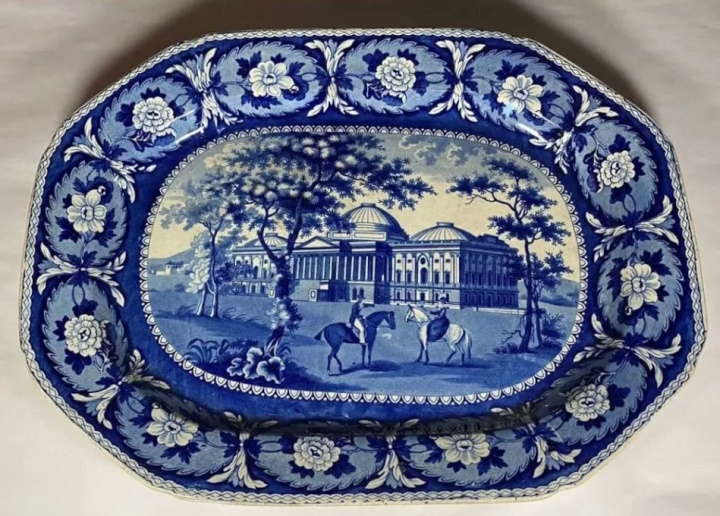 The Capitol at Washington by Ridgway, ca. 1825.
The Capitol at Washington by Ridgway, ca. 1825.
 La Grange plate, by Enoch Wood.
La Grange plate, by Enoch Wood.
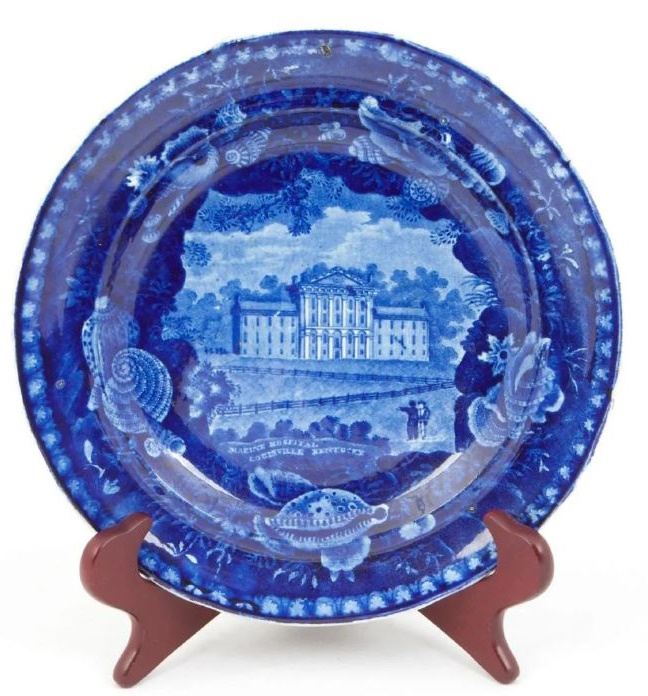 Marine Hospital plate, by Enoch Wood.
Marine Hospital plate, by Enoch Wood.
 New York from Brooklyn Heights platter.
New York from Brooklyn Heights platter.
 Three examples of ‘state coat of arms’ platters, from the early-1900s collection of the Detroit Museum of Art.
Three examples of ‘state coat of arms’ platters, from the early-1900s collection of the Detroit Museum of Art.
 The Landing of Lafayette at Castle Garden as a platter.
The Landing of Lafayette at Castle Garden as a platter.
 This is the Oatlands, Surrey platter made by Andrew Stevenson and mentioned by Sam Laidacker as having taken such a long time for Boleslaw Cybis to acquire. The portraits in the medallions are (from left to right) Thomas Jefferson, the Marquis deLafayette, DeWitt Clinton, and George Washington. The house shown is not an American one; it is Oatlands Park which was built in the late 1700s for the Duke of York. However, there is an American location shown as well: The rectangular inset at the bottom center shows a view of the Erie Canal’s Aqueduct Bridge. The platter is 16.5″ wide and still considered very rare; this one sold for $16,000 at a Virginia auction house in 2021. The auctioneer’s description included this:
This is the Oatlands, Surrey platter made by Andrew Stevenson and mentioned by Sam Laidacker as having taken such a long time for Boleslaw Cybis to acquire. The portraits in the medallions are (from left to right) Thomas Jefferson, the Marquis deLafayette, DeWitt Clinton, and George Washington. The house shown is not an American one; it is Oatlands Park which was built in the late 1700s for the Duke of York. However, there is an American location shown as well: The rectangular inset at the bottom center shows a view of the Erie Canal’s Aqueduct Bridge. The platter is 16.5″ wide and still considered very rare; this one sold for $16,000 at a Virginia auction house in 2021. The auctioneer’s description included this:
This platter’s specific order of portrait medallions combined with this particular Erie Canal view is thought to be unique. It was unrecorded prior to the Transfer Collectors Club illustrating it in their database. The TCC website write-up notes an article by Ted Gallagher, published in their Fall 2006 bulletin (“Staffordshire ‘Old Blue’ Platters in the ‘Medallion Portrait’ Series,” p. 8), “the author [Gallagher] records nine different four-medallion portrait platters by Andrew Stevenson, two of which are variants featuring this Oatlands, Surrey view.” The present platter increases the number of recorded variations to ten, three of which feature this view.
Is it possible that this platter is the same one that was owned by Boleslaw and Marja Cybis? Given the rarity of the ten known examples of this platter, it is certainly possible.
The Cybis Studio’s Reproductions
With the discovery that Boleslaw and Marja Cybis had such an intense interest in antique British export china, the question of why their 1940s studio chose to produce reproductions is now answered. As explained in the Spatterware and Historical Reproductions post, the Cybis repros were based on actual circa-1800s designs.
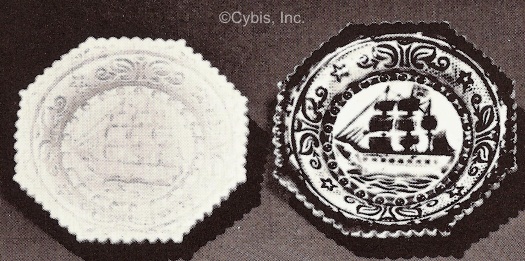

 In the case of the relief-surface cup plates, the master molds were no doubt cast from pieces that were in Boleslaw and Marja’s personal collection.
In the case of the relief-surface cup plates, the master molds were no doubt cast from pieces that were in Boleslaw and Marja’s personal collection.
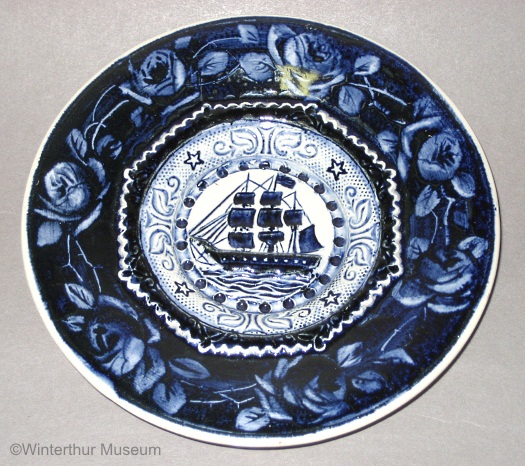 This dark blue Cybis toddy plate is now revealed as an emulation of the circa-1800s Staffordshire blue color and style.
This dark blue Cybis toddy plate is now revealed as an emulation of the circa-1800s Staffordshire blue color and style.
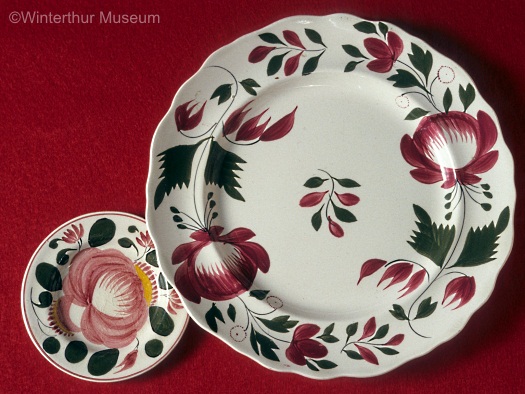
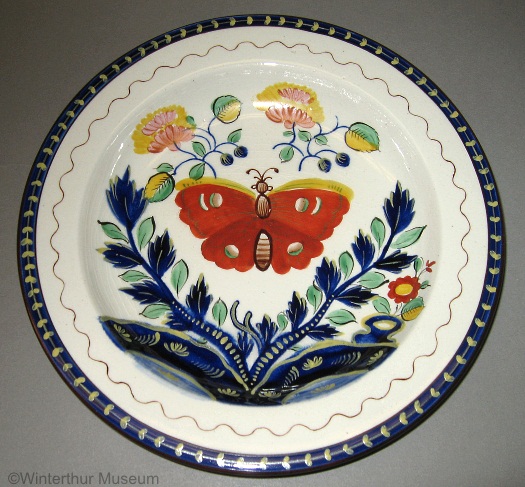 These hand-painted Cybis-studio reproductions were based on the ‘Gaudy Dutch’ items in their own collection.
These hand-painted Cybis-studio reproductions were based on the ‘Gaudy Dutch’ items in their own collection.
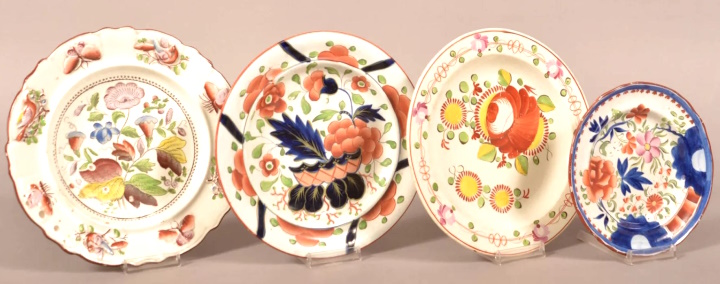 Here are some antique examples. Despite the common names (Gaudy Dutch or Gaudy Welsh), these wares were made in Britain from 1810 to 1860 and for the same purpose as the Staffordshire pieces: Export to the USA market. The sobriquets ‘Dutch’ and ‘Welsh’ are actually of American origin; in Wales, for example, these were called the ‘Swansea Cottage’ style. The actual materials spanned a range. Earthenware was the most common and the least expensive. Going up the ladder there was creamware, then ironstone, and finally bone china (what we in the USA call porcelain.)
Here are some antique examples. Despite the common names (Gaudy Dutch or Gaudy Welsh), these wares were made in Britain from 1810 to 1860 and for the same purpose as the Staffordshire pieces: Export to the USA market. The sobriquets ‘Dutch’ and ‘Welsh’ are actually of American origin; in Wales, for example, these were called the ‘Swansea Cottage’ style. The actual materials spanned a range. Earthenware was the most common and the least expensive. Going up the ladder there was creamware, then ironstone, and finally bone china (what we in the USA call porcelain.)
What prompted Boleslaw and/or Marja Cybis to begin collecting antique British-made chinaware that was originally manufactured for export to America? Was it an understandable interest in, and affection for, their adopted (albeit out of necessity) country of residence? We will never know, but to have acquired more than 2000 items in this genre is impressive. I have no idea what those items would have cost during the 1940s, but a quick check of auction houses and eBay shows what they sell for nowadays. The blue-and-white platters bring from $500 to $800 depending on condition. Plates such as La Grange go for $50-$100.
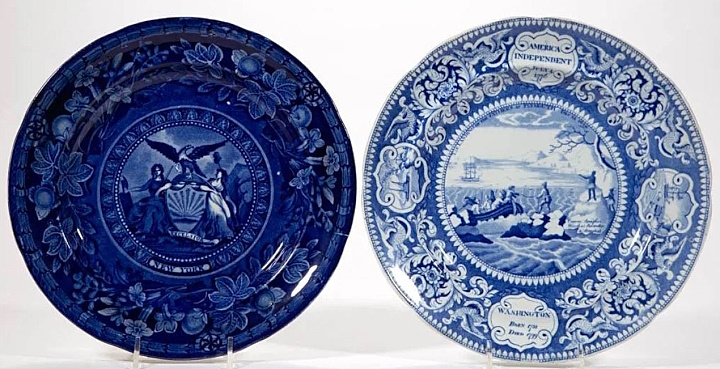 Obviously, value always depends on condition and on personal taste. Here are two contemporaneous Staffordshire transferware plates such as those that were in the Cybis collection, showing the wide variation in the color of the blue. The plate at left is the coat of arms of the State of New York, made by T. Mayer. The other plate is The Landing of the Pilgrims, made by Enoch Wood. These plates sold in November 2019 for $160 for the pair, at a Virginia auction house. If I were choosing one to buy, I’d definitely go for the left-hand plate despite the very dark color masking some of the detail, because the richness of that color appeals to me more than the other, which looks a bit ‘faded’ by comparison!
Obviously, value always depends on condition and on personal taste. Here are two contemporaneous Staffordshire transferware plates such as those that were in the Cybis collection, showing the wide variation in the color of the blue. The plate at left is the coat of arms of the State of New York, made by T. Mayer. The other plate is The Landing of the Pilgrims, made by Enoch Wood. These plates sold in November 2019 for $160 for the pair, at a Virginia auction house. If I were choosing one to buy, I’d definitely go for the left-hand plate despite the very dark color masking some of the detail, because the richness of that color appeals to me more than the other, which looks a bit ‘faded’ by comparison!
The discovery of this unexpected area of interest on the part of Boleslaw and Marja Cybis sheds a little bit of light onto what they may have been like ‘as people’ rather than focusing solely on the art that they produced. None of the Cybis Studio literature ever mentioned this particular aspect of their lives.
Name Index of Cybis Sculptures
Visual Index (for human figures/busts only)
About the Cybis Reference Archive
What is Cybis?
Images of Cybis porcelains are provided for informational and educational purposes only. All photographs are copyrighted by their owner as indicated via watermark and are used here only as reference material. Please see the Copyright Notice in the footer and sidebar for important information regarding the text that appears within this website.
The Cybis Archive is a continually-updated website that provides the most comprehensive range of information about Cybis within a single source. It is not and never has been part of the Cybis Porcelain studio, which is no longer in business.